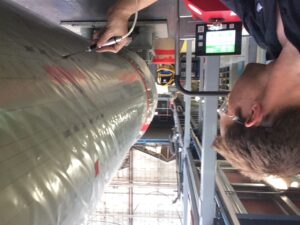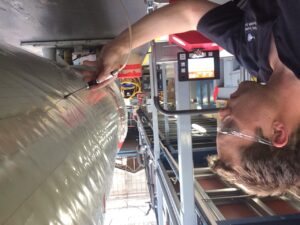So far 2017 has brought us a boom in Leak Testing. This has mostly fallen on Ben Close, who has been mentioned before in a previous West Technology news article. To showcase what West Technology can offer in regards to leak detection and testing, we asked Ben what can occur while working as an Engineer leak testing.
‘I came to West Technology as a Vacuum pump engineer, but was thrilled when I was asked if I would like to gain extra and knowledge and skills with Helium Leak Detection. I trained partly in Scotland, Pfeiffer and by West Technologies experts and pleased to say that I gained a good understanding of leak testing, however I didn’t realise how many miles were to come and just how busy it would keep me. Demand for Leak Testing is so high because various industries need accurate testing. Examples of these industries are: Pharmaceutical, Medical, Military, Food, Automotive, Aerospace, Nuclear and Oil and Gas.

 The companies which branch from the above industries are often large companies and must follow particular procedures. This is why it is so important that all attention to detail is taken care of, which applies onsite and in the office. The office staff and support are great at taking care of this and are always so efficient to take care of site service sheets and certificates.
The companies which branch from the above industries are often large companies and must follow particular procedures. This is why it is so important that all attention to detail is taken care of, which applies onsite and in the office. The office staff and support are great at taking care of this and are always so efficient to take care of site service sheets and certificates.
Different procedures apply to different companies and industries for example when I visit Power Stations (oil and gas industry) I am often required to test the Power Station Steam Ejector Vacuum Systems, often known as ‘Hoggers’. Station probe sniff test on the exhaust of the system is required. This method allows all pipework, flanges and fittings to be tested. This method is also used for small bore pipework, which is used in all kinds of industries. Pipework is pressurised with helium to a predetermined pressure and the leak detector is used to sniff for any helium leaking through damaged areas or fittings.
Internal cooling pipes in the Power Station rotors are also tested as part of the manufacturing process, the process is similar to the above and an accumulative sniff test is used.
Hard Vacuum test method is often used when testing nuclear product containers. Items are internally under vacuum and connected to the leak detector. The outside is then bagged and saturated with helium contained within the bag. The leak detector will signal any helium that has migrated from outside the vessel to inside, which will indicate the leak.
Small component accumulative leak testing is used in all kind of industries. The item is placed into a chamber, which is under vacuum and connected to the leak detector. The item is pressurised with helium. Any helium that leaks from the component is picked up via the leak detector.
To give other examples of what I have tested for is difficult, as many of the companies will not want disclose to much information and I am under a confidentiality agreement, I can however give these examples which I have recently tested: Fractional distillation plants, Air conditioning pipework, vacuum systems, linear accelerators, semiconductor process equipment, gas handling systems, heat ex changers, refrigeration assemblies and virus containment.It is really interesting to see how varied leak testing can be and always interesting how we can adapt our process to suit the industry and customer.



